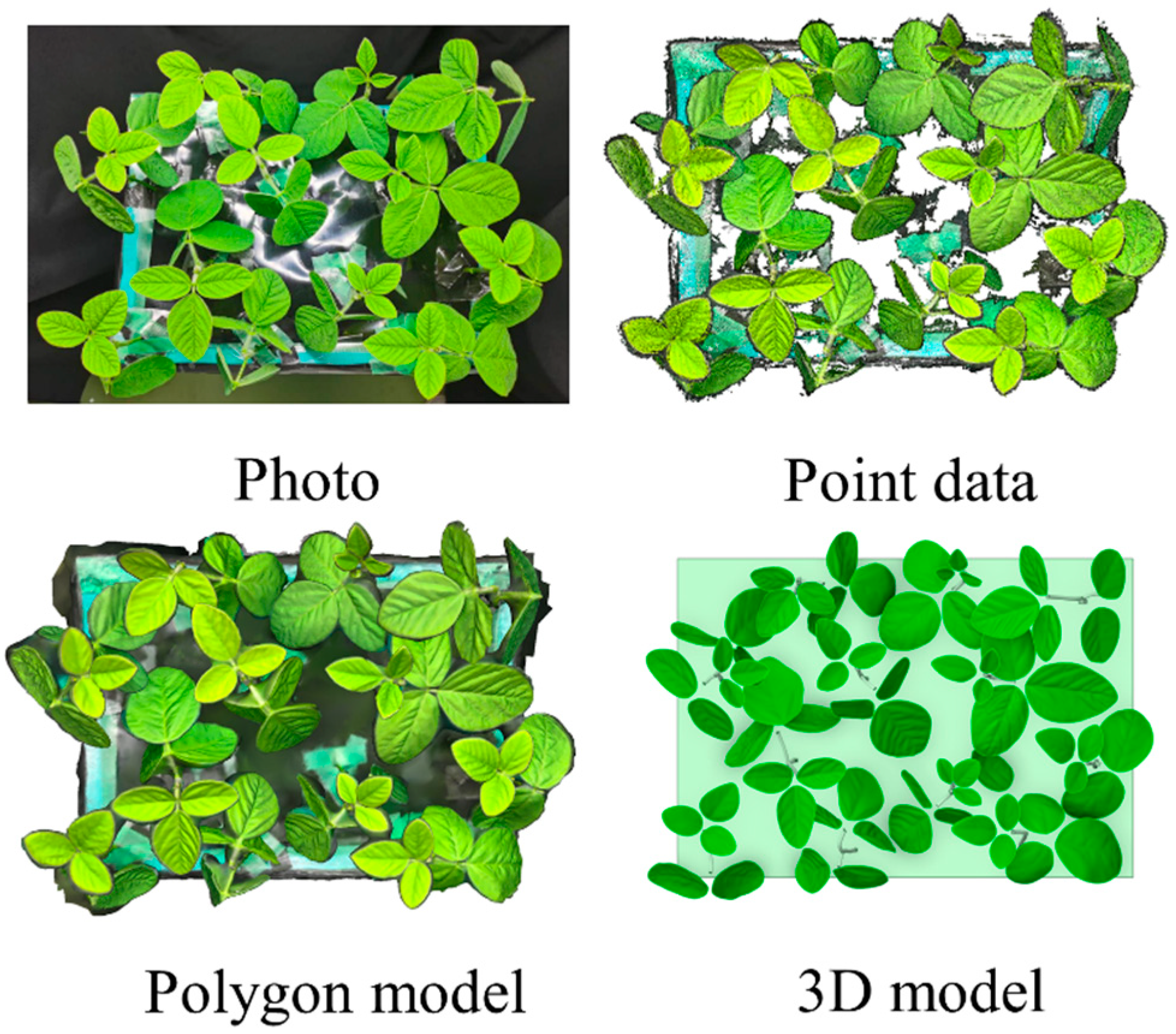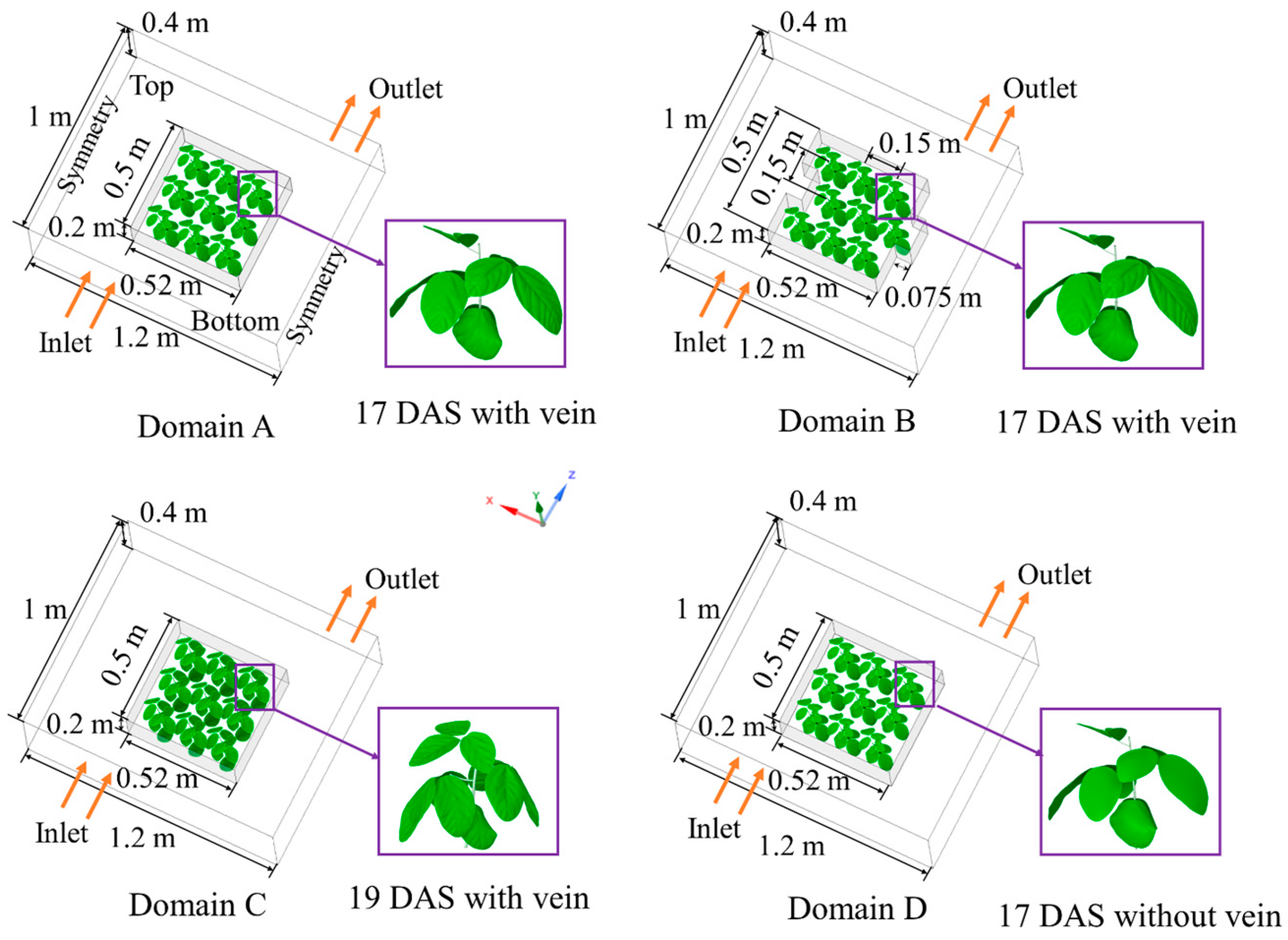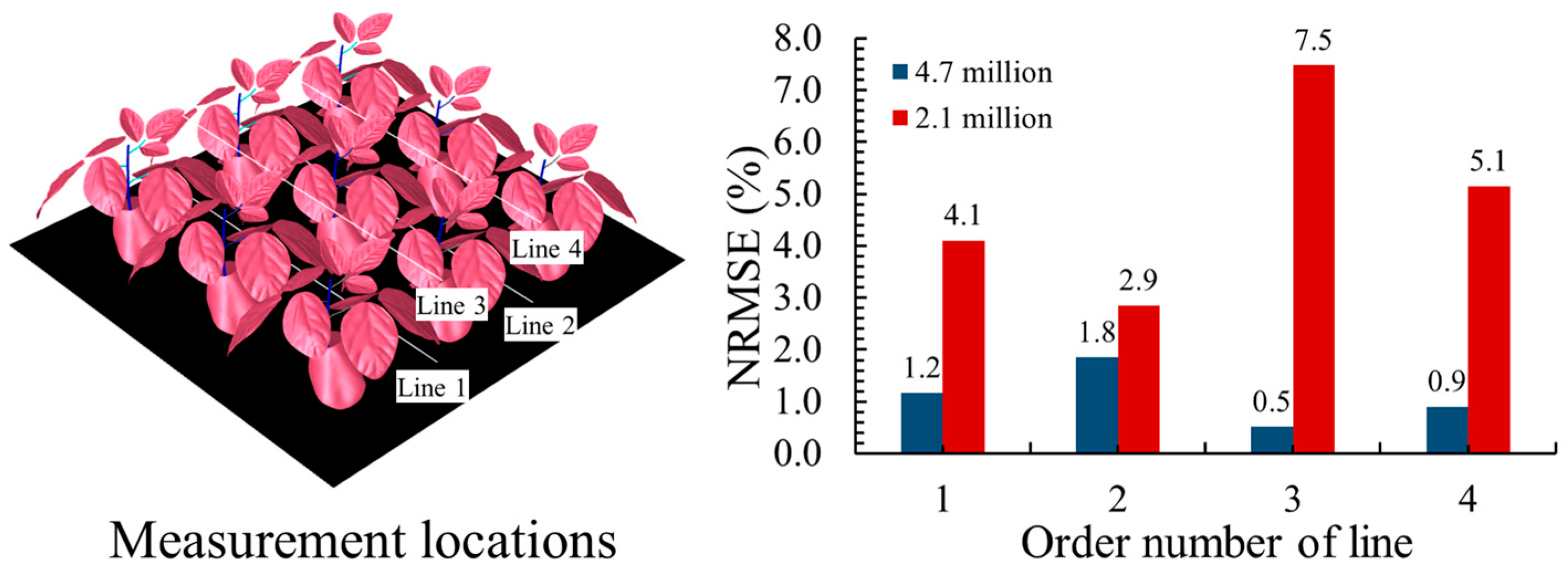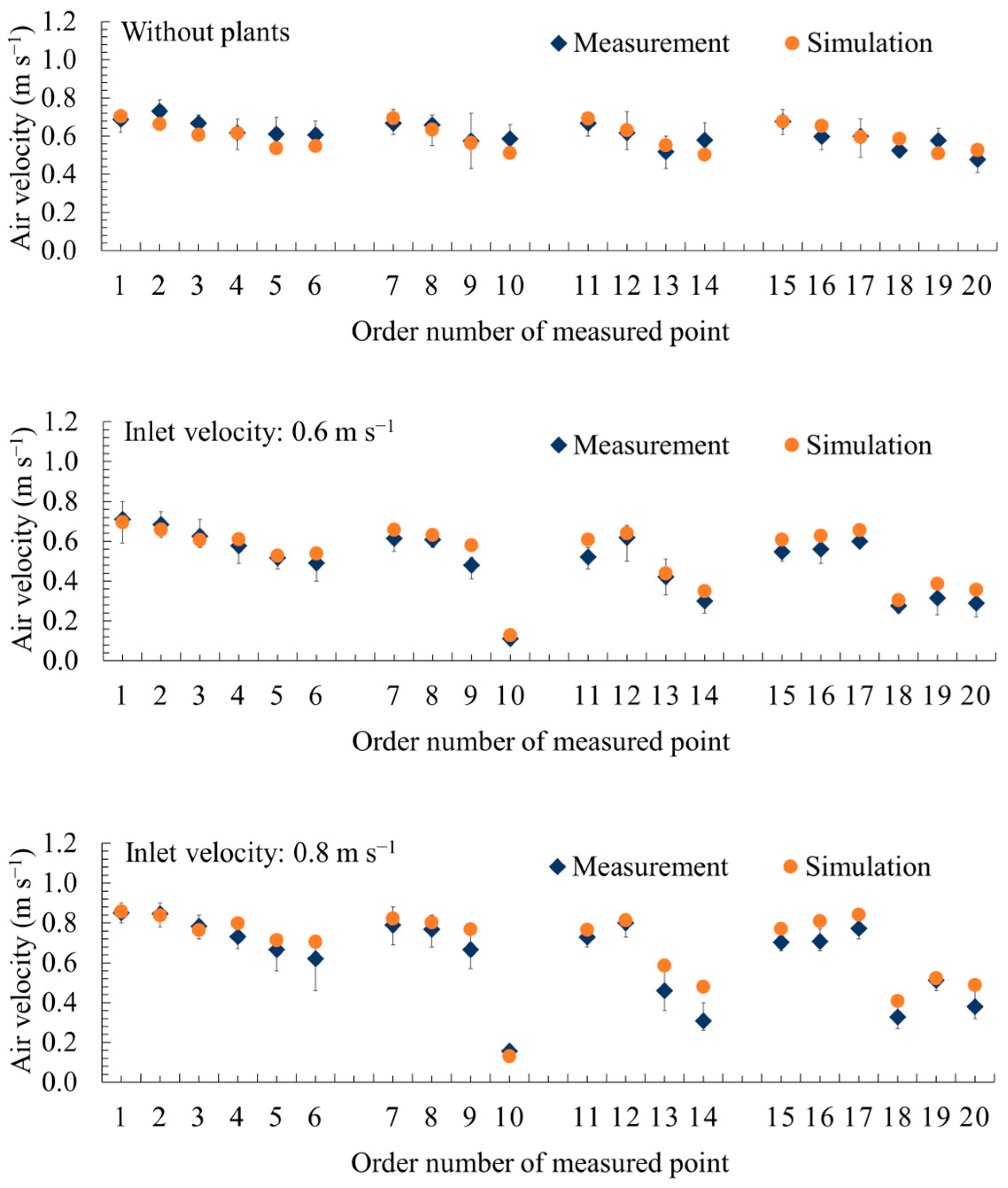Computational Fluid Dynamics Model with Realistic Plant Structures to Study Airflow in and around a Plant Canopy on a Cultivation Shelf in a Plant Factory with Artificial Light
Abstract
:1. Introduction
2. Materials and Methods
2.1. Outline of CFD Model
2.2. CFD Modelling
2.2.1. 3D Plant Canopy Models
Plant Material
3D Plant Canopy Model for CFD Model Validation
3D Plant Canopy Model for Case Simulations
2.2.2. Simulation Domains
CFD Model Validation
Case Simulations
2.2.3. Transport Equations
- (1)
- In contrast to the larger leaf area, the low thickness of leaves was ignored
- (2)
- The robust structure of the compact plant canopy presented a formidable barrier to airflow. Consequently, the minute vibrations of the leaves exert minimal influence on airflow and are therefore deemed insignificant.
2.2.4. Meshes and Boundary Conditions
2.2.5. Solver Settings
2.2.6. Experimental Measurements for CFD Model Validation
2.2.7. Processing Results
3. Results and Discussion
3.1. 3D Plant Canopy Model Validation
3.2. CFD Model Validation
3.3. Airflow in and around a Plant Canopy in Case Simulations
3.4. Stagnant Zone Distributions in Case Simulations
3.5. Normalised Air Velocity around Leaves in Case Simulations
3.6. Improving Airflow in and around a Plant Canopy
3.7. Applications of the Current CFD Model
4. Conclusions
Supplementary Materials
Author Contributions
Funding
Institutional Review Board Statement
Data Availability Statement
Acknowledgments
Conflicts of Interest
References
- Kozai, T.; Niu, G. Plant Factory: An Indoor Vertical Farming System for Efficient Quality Food Production, 2nd ed.; Elsevier: Amsterdam, The Netherlands, 2019; p. 3. [Google Scholar]
- Kozai, T.; Chun, C.; Ohyama, K. Closed systems with lamps for commercial production of transplants using minimal resources. Acta Hortic. 2004, 630, 239–252. [Google Scholar] [CrossRef]
- Kozai, T. Plant factory in Japan: Current situation and perspectives. Chron. Horticult. 2013, 53, 8–11. [Google Scholar]
- Kozai, T. Sustainable plant factory: Closed plant production systems with artificial light for high resource use efficiencies and quality produce. Acta Hortic. 2013, 1004, 27–40. [Google Scholar] [CrossRef]
- Kim, Y.H.; Kozai, T.; Kubota, C.; Kitaya, Y. Effects of air current speeds on the microclimate of plug stand under artificial lighting. Acta Hortic. 1996, 440, 354–359. [Google Scholar] [CrossRef]
- Kitaya, Y.; Shibuya, T.; Kozai, T.; Kubota, C. Effects of light intensity and air velocity on air temperature, water vapor pressure, and CO2 concentration inside a plant canopy under an artificial lighting condition. Life Support Biosph. Sci. 1998, 5, 199–203. [Google Scholar] [PubMed]
- Korthals, R.L.; Knight, S.L.; Christianson, L.L.; Spomer, L.A. Chambers for studying the effects of airflow velocity on plant growth. Biotronics 1994, 23, 113–119. [Google Scholar]
- Zhang, L.; Lemeur, R. Effect of aerodynamic resistance on energy balance and Penman–Monteith estimates of evapotranspiration in greenhouse conditions. Agric. For. Meteorol. 1992, 58, 209–228. [Google Scholar] [CrossRef]
- Kitaya, Y. Importance of air movement for promoting gas and heat exchanges between plants and atmosphere under controlled environments. In Plant Responses to Air Pollution and Global Change; Omasa, K., Nouchi, I., De Kok, L.J., Eds.; Springer: Berlin, Germany, 2005; pp. 185–193. [Google Scholar]
- Nishikawa, T.; Fukuda, H.; Murase, H. Effects of airflow for lettuce growth in the plant factory with an electric turntable. IFAC Proc. Vol. 2013, 46, 270–273. [Google Scholar] [CrossRef]
- Goto, E.; Ishigami, Y.; Kimura, K.; Arai, K.; Kashima, K.; Nakajima, H.; Maruyama, S. Optimum air current speed for rice plant canopy in a closed plant production system. Acta Hortic. 2014, 1037, 305–310. [Google Scholar] [CrossRef]
- Kitaya, Y.; Tsuruyama, J.; Kawai, M.; Shibuya, T.; Kiyota, M. Effects of air current on transpiration and net photosynthetic rates of plants in a closed plant production. In Transplant Production in the 21st Century; Kubota, C., Chun, C., Eds.; Springer: Berlin, Germany, 2000; pp. 83–90. [Google Scholar]
- Shibuya, T.; Tsuruyama, J.; Kitaya, Y.; Kiyota, M. Enhancement of photosynthesis and growth of tomato seedlings by forced ventilation within the canopy. Sci. Hortic. 2006, 109, 218–222. [Google Scholar] [CrossRef]
- Goto, E.; Takakura, T. Prevention of lettuce tipburn by supplying air to inner leaves. Trans. ASAE 1992, 35, 641–645. [Google Scholar] [CrossRef]
- Lee, J.G.; Choi, C.S.; Jang, Y.A.; Jang, S.W.; Lee, S.G.; Um, Y.C. Effects of air temperature and air flow rate control on the tipburn occurrence of leaf lettuce in a closed-type plant factory system. Hortic. Environ. Biotechnol. 2013, 54, 303–310. [Google Scholar] [CrossRef]
- Ahmed, H.A.; Tong, Y.X.; Yang, Q.C. Lettuce plant growth and tipburn occurrence as affected by airflow using a multi-fan system in a plant factory with artificial light. J. Therm. Biol. 2020, 88, 102496. [Google Scholar] [CrossRef]
- Yokoi, S.; Goto, E.; Kozai, T.; Nishimura, M.; Taguchi, K.; Ishigami, Y. Effects of planting density and air current speed on the growth and uniformity of qing-geng-cai and Spinach plug seedlings in a closed transplant production system. Environ. Control Biol. 2008, 46, 103–114. [Google Scholar] [CrossRef]
- Monteith, J.L.; Unsworth, M.H. Principles of Environmental Physics, 4th ed.; Elsevier: Amsterdam, The Netherlands, 2013; pp. 137–141. [Google Scholar]
- Saha, C.K.; Wu, W.; Zhang, G.; Bjerg, B. Assessing effect of wind tunnel sizes on air velocity and concentration boundary layers and on ammonia emission estimation using computational fluid dynamics (CFD). Comput. Electron. Agric. 2011, 78, 49–60. [Google Scholar] [CrossRef]
- Zhang, G.; Choi, C.; Bartzanas, T.; Lee, I.B.; Kacira, M. Computational fluid dynamics (CFD) research and application in agricultural and biological engineering. Comput. Electron. Agric. 2018, 149, 1–2. [Google Scholar] [CrossRef]
- Lee, I.B.; Short, T.H. Two-dimensional numerical simulation of natural ventilation in a multi-span greenhouse. Trans. ASAE 2000, 43, 745–753. [Google Scholar] [CrossRef]
- Bournet, P.E.; Boulard, T. Effect of ventilator configuration on the distributed climate of greenhouses: A review of experimental and CFD studies. Comput. Electron. Agric. 2010, 74, 195–217. [Google Scholar] [CrossRef]
- Majdoubi, H.; Boulard, T.; Fatnassi, H.; Bouirden, L. Airflow and microclimate patterns in a one-hectare Canary type greenhouse: An experimental and CFD assisted study. Agric. For. Meteorol. 2009, 149, 1050–1062. [Google Scholar] [CrossRef]
- Tamimi, E.; Kacira, M.; Choi, C.Y.; An, L. Analysis of microclimate uniformity in a naturally vented greenhouse with a high-pressure fogging system. Trans. ASABE 2013, 56, 1241–1254. [Google Scholar]
- Lim, T.G.; Kim, Y.H. Analysis of airflow pattern in plant factory with different inlet and outlet locations using computational fluid dynamics. J. Biosyst. Eng. 2014, 39, 310–317. [Google Scholar] [CrossRef]
- Baek, M.S.; Kwon, S.Y.; Lim, J.H. Improvement of the crop growth rate in plant factory by promoting airflow inside the cultivation. Int. J. Smart Home 2016, 10, 63–74. [Google Scholar] [CrossRef]
- Niam, A.G.; Muharam, T.R.; Widodo, S.; Solahudin, M.; Sucahyo, L. CFD simulation approach in determining air conditioners position in the mini plant factory for shallot seed production. In Proceedings of the AIP Conference Proceedings, Bali, Indonesia, 16–17 November 2018. [Google Scholar] [CrossRef]
- Naranjani, B.; Najafianashrafi, Z.; Pascual, C.; Agulto, I.; Chuang, P.A. Computational analysis of the environment in an indoor vertical farming system. Int. J. Heat Mass Transf. 2022, 186, 122460. [Google Scholar] [CrossRef]
- Okayama, T.; Okamura, K.; Park, J.E.; Ushada, M.; Murase, H. A simulation for precision airflow control using multi-fan in a plant factory. Environ. Control Biol. 2008, 46, 183–194. [Google Scholar] [CrossRef]
- Zhang, Y.; Kacira, M.; An, L. A CFD study on improving air flow uniformity in indoor plant factory system. Biosyst. Eng. 2016, 147, 193–205. [Google Scholar] [CrossRef]
- Fang, H.; Li, K.; Wu, G.; Cheng, R.; Zhang, Y.; Yang, Q.C. A CFD analysis on improving lettuce canopy airflow distribution in a plant factory considering the crop resistance and LEDs heat dissipation. Biosyst. Eng. 2020, 200, 1–12. [Google Scholar] [CrossRef]
- Zhang, Y.; Kacira, M. Analysis of climate uniformity in indoor plant factory system with computational fluid dynamics (CFD). Biosyst. Eng. 2022, 220, 73–86. [Google Scholar] [CrossRef]
- Haibo, Y.; Lei, Z.; Haiye, Y.; Yucheng, L.; Chunhui, L.; Yuanyuan, S. Sustainable development optimization of a plant factory for reducing tip burn disease. Sustainability 2023, 15, 5607. [Google Scholar] [CrossRef]
- Lee, S.W.; Seo, I.H.; An, S.W.; Na, H.Y. Improvement of environmental uniformity in a seedling plant factory with porous panels using computational fluid dynamics. Horticulturae 2023, 9, 1027. [Google Scholar] [CrossRef]
- Kang, L.; van Hooff, T. Numerical evaluation and optimization of air distribution system in a small vertical farm with lateral air supply. Dev. Built Environ. 2024, 17, 100304. [Google Scholar] [CrossRef]
- Boulard, T.; Roy, J.C.; Pouillard, J.B.; Fatnassi, H.; Grisey, A. Modelling of micrometeorology, canopy transpiration and photosynthesis in a closed greenhouse using computational fluid dynamics. Biosyst. Eng. 2017, 158, 110–133. [Google Scholar] [CrossRef]
- Bouhoun Ali, H.; Bournet, P.E.; Cannavo, P.; Chantoiseau, E. Development of a CFD crop submodel for simulating microclimate and transpiration of ornamental plants grown in a greenhouse under water restriction. Comput. Electron. Agric. 2018, 149, 26–40. [Google Scholar] [CrossRef]
- Duga, A.T.; Dekeyser, D.; Ruysen, K.; Bylemans, D.; Nuyttens, D.; Nicolai, B.M.; Verboven, P. Numerical analysis of the effects of wind and sprayer type on spray distribution in different orchard training systems. Bound.-Layer Meteorol. 2015, 157, 517–535. [Google Scholar] [CrossRef]
- Hong, S.W.; Zhao, L.; Zhu, H. CFD simulation of pesticide spray from air-assisted sprayers in an apple orchard: Tree deposition and off-target losses. Atmos. Environ. 2018, 175, 109–119. [Google Scholar] [CrossRef]
- Liu, C.; Zheng, Z.; Cheng, H.; Zou, X. Airflow around single and multiple plants. Agric. For. Meteorol. 2018, 252, 27–38. [Google Scholar] [CrossRef]
- Liu, R.; Zhang, J.; Yang, X.; Liu, S.; Kang, L. Simulating airflow around flexible vegetative windbreaks. J. Geophys. Res. Atmos. 2021, 126, e2021JD034578. [Google Scholar] [CrossRef]
- Su, J.; Wang, L.; Gu, Z.; Song, M.; Cao, Z. Effects of real trees and their structure on pollutant dispersion and flow field in an idealized street canyon. Atmos. Pollut. Res. 2019, 10, 1699–1710. [Google Scholar] [CrossRef]
- Guo, Z.; Yang, X.; Wu, X.; Zou, X.; Zhang, C.; Fang, H.; Xiang, H. Optimal design for vegetative windbreaks using 3D numerical simulations. Agric. For. Meteorol. 2021, 298–299, 108290. [Google Scholar] [CrossRef]
- Endalew, A.M.; Hertog, M.; Delele, M.A.; Baetens, K.; Persoons, T.; Baelmans, M.; Ramon, H.; Nicolaï, B.M.; Verboven, P. CFD modelling and wind tunnel validation of airflow through plant canopies using 3D canopy architecture. Int. J. Heat Fluid Flow 2009, 30, 356–368. [Google Scholar] [CrossRef]
- Yu, G.; Zhang, S.; Li, S.; Zhang, M.; Benli, H.; Wang, Y. Numerical investigation for effects of natural light and ventilation on 3D tomato body heat distribution in a Venlo greenhouse. Inf. Process. Agric. 2023, 10, 535–546. [Google Scholar] [CrossRef]
- Kim, D.; Kang, W.H.; Hwang, I.; Kim, J.; Kim, J.H.; Park, K.S.; Son, J.E. Use of structurally accurate 3D plant models for estimating light interception and photosynthesis of sweet pepper (Capsicum annuum) plants. Comput. Electron. Agric. 2020, 177, 105689. [Google Scholar] [CrossRef]
- Ohashi, Y.; Torii, T.; Ishigami, Y.; Goto, E. Estimation of the light interception of a cultivated tomato crop canopy under different furrow distances in a greenhouse using the ray tracing. J. Agric. Meteorol. 2020, 76, 188–193. [Google Scholar] [CrossRef]
- Saito, K.; Ishigami, Y.; Goto, E. Evaluation of the light environment of a plant factory with artificial light by using an optical simulation. Agronomy 2020, 10, 1663. [Google Scholar] [CrossRef]
- Liu, Q.; Ke, X.; Yoshida, H.; Hikosaka, S.; Goto, E. Optimizing photosynthetic photon flux density and light quality for maximizing space use efficacy in edamame at the vegetative growth stage. Front. Sustain. Food Syst. 2024, 8, 1407359. [Google Scholar] [CrossRef]
- Wang, K.C. Food safety and contract edamame: The geopolitics of the vegetable trade in East Asia. Geogr. Rev. 2018, 108, 274–295. [Google Scholar] [CrossRef]
- Moriondo, M.; Leolini, L.; Staglianò, N.; Argenti, G.; Trombi, G.; Brilli, L.; Dibari, C.; Leolini, C.; Bindi, M. Use of digital images to disclose canopy architecture in olive tree. Sci. Hortic. 2016, 209, 1–13. [Google Scholar] [CrossRef]
- Fluent User’s Guide. version 2021 R2. ANSYS Inc.: Canonsburg, PA, USA, 2021.
- Wang, H.; Zhai, Z.J. Analyzing grid independency and numerical viscosity of computational fluid dynamics for indoor environment applications. Build. Environ. 2012, 52, 107–118. [Google Scholar] [CrossRef]
- Zhang, Y.; Yasutake, D.; Hidaka, K.; Kitano, M.; Okayasu, T. CFD analysis for evaluating and optimizing spatial distribution of CO2 concentration in a strawberry greenhouse under different CO2 enrichment methods. Comput. Electron. Agric. 2020, 179, 105811. [Google Scholar] [CrossRef]
- Kitaya, Y.; Shibuya, T.; Yoshida, M.; Kiyota, M. Effects of air velocity on photosynthesis of plant canopies under elevated CO2 levels in a plant culture system. Adv. Space Res. 2004, 34, 1466–1469. [Google Scholar] [CrossRef]
- Wang, H.W. Fluid Mechanics as I Understand It, 2nd ed.; National Defense Industry Press: Beijing, China, 2020; pp. 130–151. [Google Scholar]
- Jay, S.; Rabatel, G.; Hadoux, X.; Moura, D.; Gorretta, N. In-field crop row phenotyping from 3D modeling performed using Structure from Motion. Comput. Electron. Agric. 2015, 110, 70–77. [Google Scholar] [CrossRef]
- Roy, J.C.; Vidal, C.; Fargues, J.; Boulard, T. CFD based determination of temperature and humidity at leaf surface. Comput. Electron. Agric. 2008, 61, 201–212. [Google Scholar] [CrossRef]








| Inflow Velocity (m s−1) | Arrangement | DAS * (Day) | LAI (m−2 m−2) | |
|---|---|---|---|---|
| Case 1 | 0.20 | Square | 17 | 1.00 |
| Case 2 | 0.50 | Square | 17 | 1.00 |
| Case 3 | 0.80 | Square | 17 | 1.00 |
| Case 4 | 0.50 | Stagger | 17 | 1.00 |
| Case 5 | 0.50 | Square | 19 | 1.40 |
| Case 6 | 0.50 | Square | 17 | 0.99 |
| Inflow Velocity (m s−1) | Vmax (m s−1) | Vavg (m s−1) | PC (<0.20 m s−1) (%) | PC (0.20–0.50 m s−1) (%) | PC (>0.50 m s−1) (%) | CV (%) | |
|---|---|---|---|---|---|---|---|
| Case 1 | 0.2 | 0.33 ± 0.00 | 0.12 ± 0.00 | 62.3 ± 0.02 | 37.7 ± 0.02 | 0.0 ± 0.00 | 103.4 ± 0.00 |
| Case 2 | 0.5 | 0.72 ± 0.00 | 0.36 ± 0.00 | 16.4 ± 0.03 | 58.2 ± 0.01 | 25.4 ± 0.02 | 91.1 ± 0.22 |
| Case 3 | 0.8 | 1.21 ± 0.00 | 0.55 ± 0.00 | 7.2 ± 0.02 | 36.9 ± 0.03 | 56.0 ± 0.02 | 86.4 ± 0.25 |
| Case 4 | 0.5 | 0.77 ± 0.00 | 0.37 ± 0.00 | 13.1 ± 0.10 | 59.5 ± 0.06 | 27.3 ± 0.04 | 87.1 ± 0.19 |
| Case 5 | 0.5 | 0.79 ± 0.00 | 0.33 ± 0.00 | 25.6 ± 0.15 | 50.4 ± 0.06 | 24.0 ± 0.11 | 92.8 ± 0.12 |
| Case 6 | 0.5 | 0.71 ± 0.00 | 0.36 ± 0.00 | 15.6 ± 0.00 | 58.9 ± 0.00 | 25.4 ± 0.00 | 77.1 ± 0.08 |
Disclaimer/Publisher’s Note: The statements, opinions and data contained in all publications are solely those of the individual author(s) and contributor(s) and not of MDPI and/or the editor(s). MDPI and/or the editor(s) disclaim responsibility for any injury to people or property resulting from any ideas, methods, instructions or products referred to in the content. |
© 2024 by the authors. Licensee MDPI, Basel, Switzerland. This article is an open access article distributed under the terms and conditions of the Creative Commons Attribution (CC BY) license (https://creativecommons.org/licenses/by/4.0/).
Share and Cite
Gu, X.; Goto, E. Computational Fluid Dynamics Model with Realistic Plant Structures to Study Airflow in and around a Plant Canopy on a Cultivation Shelf in a Plant Factory with Artificial Light. Agriculture 2024, 14, 1199. https://doi.org/10.3390/agriculture14071199
Gu X, Goto E. Computational Fluid Dynamics Model with Realistic Plant Structures to Study Airflow in and around a Plant Canopy on a Cultivation Shelf in a Plant Factory with Artificial Light. Agriculture. 2024; 14(7):1199. https://doi.org/10.3390/agriculture14071199
Chicago/Turabian StyleGu, Xuan, and Eiji Goto. 2024. "Computational Fluid Dynamics Model with Realistic Plant Structures to Study Airflow in and around a Plant Canopy on a Cultivation Shelf in a Plant Factory with Artificial Light" Agriculture 14, no. 7: 1199. https://doi.org/10.3390/agriculture14071199





